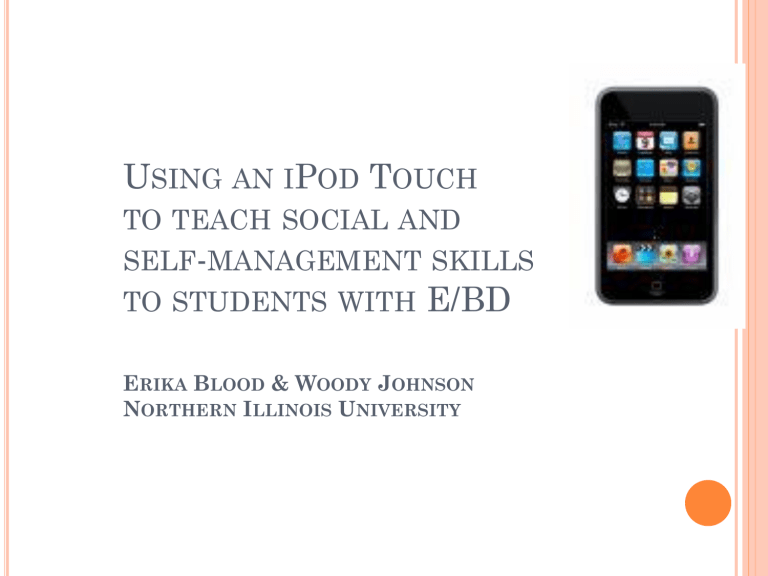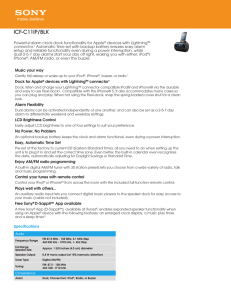Using Video Modeling to Teach Daily Living Skills to

U SING AN I P OD T OUCH
TO TEACH SOCIAL AND
SELF MANAGEMENT SKILLS
TO STUDENTS WITH E/BD
E RIKA B LOOD & W OODY J OHNSON
N ORTHERN I LLINOIS U NIVERSITY
PURPOSE OF PRESENTATION
Video-based instruction has been used effectively to teach various skills to individuals with disabilities.
Although researchers have demonstrated its effectiveness, few educators are using this technology.
The purpose of this presentation is to provide an overview of research and to demonstrate how video materials can be created using common software applications and how video-based materials can be presented on video iPods.
V IDEO -B ASED I NSTRUCTION
Video-based instruction has been used effectively as a technique for teaching functional skills.
More and more researchers are investigating the use of multimedia applications for teaching critical skills using portable, handheld solutions.
V ARIATIONS WITH V IDEO -B ASED
I NSTRUCTION
Type of Model
Self-modeling: Video self-modeling (VSM)
is a technique that allows learners to observe themselves engaging in positive performances of a target behavior and has been used to teach skills such as math
(Schunk & Hanson, 1989) language
(Buggey, 1995; Buggey, 2005) and social skills (Buggey, 2005; Lonnecker, Brady,
McPherson, & Hawkins, 1994), Kern-
Dunlap et al, 1992).
V ARIATIONS WITH V IDEO -B ASED
I NSTRUCTION ( CONT )
Other Models: Involves taping models other than the learner to demonstrate skills, or to serve as models in instructional videos.
Peer models have been used to instruct persons on community skills (Branham et al., 1999) vocational skills (Martin et al., 1992), social skills
(Nikopoulos & Keenan, 2004), and cooking skills
(Bidwell & Rehfeldt, 2004).
Other models have been used for a variety of skills including social and communication skills
(Charlop & Milstein, 1989; Charlop-Christy et al.,
2000; Conyers et al., 2004; LeBlanc et al., 2003), daily living skills (Van Laarhoven & Van
Laarhoven-Myers, 2006), and community skills
(Alcantara, 1994; Ayers & Langone, 2002).
V ARIATIONS WITH V IDEO -B ASED
I NSTRUCTION ( CONT )
Subjective Models: With this approach, the learner watches the video as if they were completing the task themselves.
Typically, there is no model present, but rather, learners watch a video that shows what it would look like if they were completing the task.
Subjective models have been used for video instruction of various skills, including self help skills (Norman et al., 2001), daily living skills
(Shipley-Benamou, Lutzker, & Taubman, 2002), behavior regulation/transitioning from one activity to the next (Schreibman, Whalen, &
Stahmer, 2000), and cooking skills (Graves et al.,
2005).
V ARIATIONS WITH V IDEO -B ASED
I NSTRUCTION ( CONT )
Video feedback typically involves having the learner evaluate their own performance by watching themselves engage in the task, or by watching a positive example of someone performing the skill as an error correction procedure.
VARIATIONS WITH VIDEO-BASED
INSTRUCTION (CONT)
Self-evaluation Video Feedback Learners are shown a video of their own performance following task engagement (they are videotaped as they engage in the task and view the tapes of themselves following practice).
Self-evaluation feedback has often been part of a treatment package and has been used to reduce challenging behavior (Embregts, 2000; Embregts,
2002; Embregts, 2003), decrease playground aggression and increase pro-social behavior (O’Reilly et al 2005), increase on-task behavior (Walther & Beare,
1991) and to teach social communication (Maione &
Mirenda, 2006; Thieman & Goldstein), daily living skills (Lasater & Brady, 1995), and shopping skills
(Haring et al., 1987).
V ARIATIONS WITH V IDEO -B ASED
I NSTRUCTION ( CONT )
Error Correction Feedback Learners are shown a positive model of either themselves or someone else performing the skill correctly following errors (they watch a correct performance of the task if they make an error) (Goodson, et al., 2007;
Van Laarhoven, Van Laarhoven-Myers, & Zurita,
2007).
This form of video feedback has been used in conjunction with video modeling procedures, which involves having learners first watch a video-based skill sequence prior to engaging in the activity, or video prompting procedures, which involves having learners watch a “step” in a skill sequence prior to engaging in that particular step.
V ARIATIONS WITH V IDEO -B ASED
I NSTRUCTION ( CONT )
Video Modeling refers to an instructional approach where learners view an entire video skill sequence prior to engaging in a task. This has also been referred to as “video priming”
(Schreibman et al., 2000) or “video rehearsal”
(Van Laarhoven & Van Laarhoven-Myers, 2006).
V ARIATIONS WITH V IDEO -B ASED
I NSTRUCTION ( CONT )
Video prompting An instructional approach that involves showing each step in a skill sequence on video followed immediately by task engagement with that particular step
(Cihak et al., 2004; Van Laarhoven, Johnson,
Van Laarhoven-Myers, Grider & Grider,
2009).
This requires that the learner has access to a television, computer, iPod, or portable DVD player in the environment where the skill is being practiced so that they can watch a clip, go perform the step, and then return to the device to complete the remainder of the steps.
VIDEO-BASED INSTRUCTION FOR
STUDENTS WITH EBD
Emerging literature base surrounding the use of video-modeling specifically for students with EBD
Baker, Lang, O’Reilly, 2009
To date, studies have focused on using a combination of video-modeling (or self-modeling) and discussion
(teacher/therapist) to:
increase positive peer interactions
increase on-task behavior decrease inappropriate behavior
T EACHING S OCIAL S KILLS
P URPOSE
To determine if a combination of video modeling, on an iPod Touch, and a daily check-in sheet results in increases in appropriate behavior during morning routine and small group instruction.
•
•
Setting
–
All baseline and instructional sessions took place at a table in the special education classroom in an elementary school in northern Illinois.
Math Group Instruction
–
All math group instruction was conducted by a paraprofessional.
–
The target student and 2-3 other students sat at a table with across from the paraprofessional.
–
Math instruction was highly structured and conducted in a model-lead-test format. Students were provided with frequent opportunities for active responding, and received high rates of descriptive praise for behaving appropriately, following directions, and completing work.
V IDEO M ODELING
•
•
•
•
A short (5 min.) video sequence was recorded with peers as models.
The peers demonstrated engaging in appropriate on-task behavior, following directions, and completing work.
A narration was added to describe the expectations of Math Group while each expectation was demonstrated by the models.
The video was loaded onto an iPod Touch
M ORNING R OUTINE V IDEO
P ROCEDURES
At the beginning of the video modeling phase, the teacher explained to Andy that he would be watching a short video before math to help remind him of the expectations during math group.
Immediately before math group, the paraprofessional prompted Andy to touch the icon on the iPod Touch to play the video.
Target Behaviors
Disruptive
Talking or Blurting out, inappropriate language
Off task
out of seat, dancing/silly, bothering others, waiving/flapping pencil
On task
Attending to teacher, following directions, appropriately manipulating materials, working independently
Data Collection
Observer(s) collected data during math group 2-3 times per week.
On task/Off task behavior was recorded using momentary time sampling with 15 second intervals.
Disruptive behavior was recorded using partial interval recording with 15 second intervals.
Two observers were present during 25 % of the observation sessions. IOA = 94% for On Task/Off Task and 91 % for
Disruptive Behavior
M ATH G ROUP V IDEO
M ATH G ROUP V IDEO M ODELING
Baseline Video Modeling on iPod Touch
100
80
60
40
20
0
1 2 3 4 5 6
Sessions
7 8 9 10 11
On Task
Disruptive
S ELF M ONITORING
Four Components
Goal setting
Self-monitoring
Self-instruction
Self-reinforcement
Goal Setting
Goals should be:
Specific and measurable
Appropriate level of difficulty (not too hard, not too easy)
Attainable in a short period of time (Graham, 1992)
S ELF -M ONITORING
Self-Monitoring begins with
Self-assessment
Student observes his/her own behavior
Self-record
Student records behaviors s/he observed
IMPORTANT: Reinforces existing skills, doesn’t teach new skills (Graham, 1992)
S ELF -I NSTRUCTION
Student instruct him/herself either overtly or covertly to regulate own behavior
Self-instruction used to
Direct attention
Control behavior
Focus thinking
Assist memory
Complete a task
Manage emotional reactions
Determine success criteria (Graham, 1992)
Students actively participate in the development of the self-instruction procedure
Teacher must teach students how to implement the procedures
Teacher teaches and gradually fades prompting
S ELF R EINFORCEMENT
Student evaluates own behavior
Student determines if the behavior meets the pre-identified criteria and provides reinforcement
Student records behavior
Teacher usually spot checks this for accuracy and may provide additional reinforcement
S USAN
Susan disrupts lesson by constantly making off-topic comments in class (baseline ave. 3.5 times per 15 min.)
Teacher instructs Susan how to record her off-topic comments on a chart by putting an “X” over a “mouth” indicating the 15 minute interval in which each “talk out” occurred.
Teacher reminds Susan to record her behavior in the beginning (as needed)
Teacher prompts are gradually faded
Susan is reinforced by teacher attention at the end of the lesson for recording her off-topic comments, and
Teacher provides an activity reward if her off topic comments decrease to an acceptable level as identified on her goal
The acceptable level is gradually reduced when she meets a criterion
Step 1
TALK OUTS Time
9:00-9:15
9:15-9:30
9:30-9:45
9:45-10:00
Were you able to circle yes 3 out of 4 times?
One left?
Yes No
Yes No
Yes No
Yes No
I did!
Not this time.
Step 2
TALK OUTS Time
9:00-9:15
9:15-9:30
9:30-9:45
9:45-10:00
Were you able to circle yes 4 out of 4 times?
One left?
Yes No
Yes No
Yes No
Yes No
I did!
Not this time.
Step 3
TALK OUTS Time
9:00-9:15
9:15-9:30
9:30-9:45
9:45-10:00
Were you able to circle yes 4 out of 4 times?
One left?
Yes No
Yes No
Yes No
Yes No
I did!
Not this time.
Step 4
Time
9:00-9:15
9:15-9:30
TALK OUTS One left?
Yes No
Yes No
9:30-9:45 Yes No
9:45-10:00 Yes No
Were you able to circle yes 4 out of 4 times?
I did!
Not this time.
Time
9:00-9:30
9:30-10:00
Step 5
TALK OUTS
Were you able to circle yes 2 out of 2 times?
One left?
Yes No
Yes No
I did!
Not this time.
N OW B ACK TO ANDY!
While video modeling led to improved on-task behavior and deductions in the number of disruption, his performance still varied from day to day.
The team decided to add self-monitoring to
Andy’s intervention package.
Since he had responded well to video models, the decision was made to use video to teach selfmonitoring skills.
Andy is was taught to self monitor his “on task” behavior.
During the initial instruction phase, Andy viewed video of himself while learning to independently discriminate his own “on task” and “off task” behavior.
Video self-modeling was then used to teach him to selfrecord his behavior using the
“Timer” application on the iPod and a self monitoring sheet.
S ELF M ONITORING V IDEO
V IDEO M ODELING + S ELF M ONITORING
Baseline Video Modeling Video Modeling + Self Monitoring
100
80
60
40
20
0
1 2 3 4 5 6 7 8 9 10 11 12 13 14 15 16 17 18
Sessions
On Task
Disruptive
HOW YOU PREPARE VIDEO BASED
MATERIALS FOR USE WITH AN
I P OD
P REPARING V IDEO BASED I NSTRUCTION
ON THE I P OD T OUCH !
F IRST , YOU HAVE TO RECORD VIDEO AND
EDIT ON A DESKTOP COMPUTER
Video files have to be saved in a format that will work on the iPod (MP4).
Mac users can use iMovie
PC users can use Windows Movie Maker, but each file will have to be converted a video conversions program.
Pinnacle Studio will allow PC users to edit video and save files in the MP4 format.
Pinnacle is similar to Movie Maker but has some nice features.
Pinnacle sells for around $100 depending on the features and is well worth the investment.
http://www.jankuj.com/Picture_Scheduler.html
The “Picture Scheduler” is an inexpensive application (less than $3) that is very useful for arranging a sequence of video segments or pictures with voice narrations.
Open the app and create a new
“category” by clicking the little file folder in the bottom left corner.
Create a new “task” or sequence by touching the little plus sign in the top right corner.
U
SE I
T
UNES TO TRANSFER VIDEO FILES FROM A DESKTOP COMPUTER
TO THE I P OD T OUCH USING THE FILE SHARING FEATURE OF I T UNES
Entering information under “Create new task”
If desired, an “Alert” can be set up to notify the students at a specific day and time.
An audio narration can be assed directly onto the iPod by selecting “audio”
Video files can be selected from those available on the iPod.
Once the videos are on the iPod, can begin to set them up in a sequence by touching
“save” after you have selected the picture, typed in the name, and selected the video for each step or activity in the sequence. If you wish for the sequence to be in a specific order, start with the last video and work up to the first.
Y OU CAN SAVE MULTIPLE SEQUENCES OR
“ LISTS ” ON ONE I P OD T OUCH
T HANK Y OU !
Erika Blood
eblood@niu.edu
Woody Johnson
jwjohnson@niu.edu








